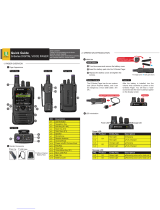
Turning Off the Bluetooth Audio
(Routing the Audio from the
Headset to the Radio)..................148
Adjusting the Volume of the Radio
from Bluetooth Audio Device....... 148
Viewing and Clearing the Bluetooth
Device Information.......................149
Clearing All Bluetooth Devices
Information...................................150
Editing the Bluetooth Friendly
Name........................................... 151
Programming Over Project 25 (POP 25)
(ASTRO 25 and ASTRO Conventional). 151
Responding to the Notification of
Upgrade....................................... 151
Voice Announcement...................................152
Site Selectable Alerts (ASTRO 25)..............153
Sending SSA Notification to Single
Site...............................................153
Sending SSA Notification to Single
Site Via Manual Entry.................. 154
Sending SSA Notification to All
Sites.............................................155
Sending SSA Notification to All
Available Sites............................. 156
Stopping SSA Notification of a
Single Site....................................156
Stopping SSA Notification of a
Single Site Via Manual Entry....... 157
Stopping SSA Notification of All
Sites.............................................158
Stopping SSA Notification of All
Available Sites............................. 158
Utilities......................................................... 159
Viewing Recent Calls........................159
Using the Flip Display....................... 160
Selecting a Basic Zone Bank............160
Selecting an Enhanced Zone Bank.. 160
Selecting the Power Level................ 161
Selecting a Radio Profile...................161
Enabling and Disabling the Radio
Alias............................................. 162
Selecting the Audio Speaker.............162
Controlling the Display Backlight...... 163
Locking and Unlocking the Keypad
and Controls................................ 164
Turning the Controls and Keypad
Buttons Tones On or Off..............164
Turning Voice Mute On or Off...........165
Using the Time-Out Timer.................165
Time and Date Setup........................166
Using Conventional Squelch
Operation Features......................167
Using the PL Defeat Feature............ 167
6
English























